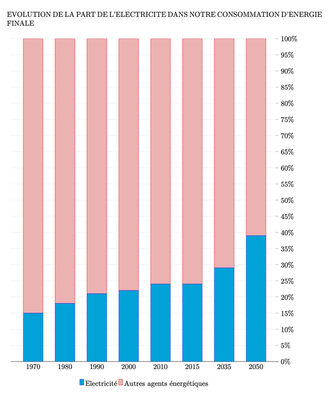Why are we consuming more and more electricity?
Our electricity consumption is increasing for three reasons. First, it is irreplaceable for many services, such as lighting and electronics, which are increasingly used in our technological society. Second, the development of electrical mobility and services to an aging population will also contribute to the increase in needs. Third, the consumption of pumped storage for electricity storage (especially renewable) will also increase.
Between 2000 and 2010, the demand for final energy in Switzerland increased by 7%, before decreasing by the same amount in 2018 due to milder weather conditions. Over the same period, electricity consumption increased by 10% (+ 5.5 TWh), from 52 to 57.5 TWh. As a result of this trend, the share of electricity in our energy consumption is slowly but steadily increasing. In 2018, electricity accounted for 25% of our total consumption, compared with only 20% in 1990. This trend began in the 1970s, following the oil shocks of 1973 and 1979 [→ Q10].
This growth is not the result of a dominant application. On the contrary, between 2000 and 2018, with the exception of lighting, all uses of electricity increased, in particular: heating (+ 1 TWh), air-conditioning (+ 1.2 TWh), electronic appliances (+ 0.5 TWh), electric mobility (+ 0.5 TWh). Our society as a whole is therefore gradually becoming more electrified. It should be noted that the increase in heating consumption is not due to direct electric heating (which we are trying to ban, [→ Q26]), but to the operation of the heat pumps, which are becoming increasingly widespread [→ Q59].
In percentage terms, electronic appliances generated a sharp increase in consumption between 2000 and 2018: + 23% (from 2.4 to 3.1 TWh, or + 0.7 TWh)! This is not surprising, given the proliferation of these appliances. Nevertheless, in absolute figures, the total consumption of these appliances remains marginal, since it represents less than 6% of our total electricity consumption.
The trend toward electrification is likely to continue in the coming decades. The share of electricity in the Swiss energy mix could be around 30% in 2035 and close to 40% in 2050, regardless of the scenario considered [→ Q87] [→ see figure below]. The strongest growth will come from electric cars [→ Q35], and from pumped storage for electricity storage [→ Q73].
Of course, our society’s electrification process further increases the challenge of moving away from nuclear power.

References
- Kemmler, Spillmann & Koziel (2018)
- Kemmler, A., Spillmann, T. & Koziel, S. (2018). Ex-post-analyse des schweizerischen energieverbrauchs 2000-2017 nach bestimmungsfaktoren. Office fédéral de l'énergie (OFEN).
- Kemmler, A and Koziel, S and Wüthrich, P and Notter, B and Keller, M and Jakob, M and Catenazzi, G (2017)
- Kemmler, A and Koziel, S and Wüthrich, P and Notter, B and Keller, M and Jakob, M and Catenazzi, G (2017). Analyse des schweizerischen Energieverbrauchs 2000-2016 nach Verwendungszwecken. Office fédéral de l'énergie (OFEN).
- Office fédéral de l'énergie (OFEN) (2018)
- Office fédéral de l'énergie (OFEN) (2018). Statistique suisse de l’électricité 2018. OFEN.
- Office fédéral de l'énergie (OFEN) (2013)
- Office fédéral de l'énergie (OFEN) (2013). Perspectives énergétiques 2050.
- Office fédéral de l'énergie (OFEN) (2019)
- Office fédéral de l'énergie (OFEN) (2019). Statistique globale de l’énergie 2018. OFEN.